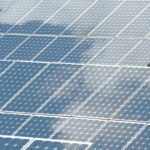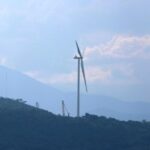Hedged financial structures with guaranteed production for wind farms are misdiagnosed with respect to weather risk, with asymmetric price risk, meteorologically unrealistic production assurances and strike prices that do not reflect long-term electricity prices.
As renewables increase as a percentage of US generating capacity, the consequences of misdiagnosis of financial risk in hedges increases proportionally.
The five-day Texas cold snap in February caused wind farms in ERCOT to sustain financial impacts of more than $4 billion—greater than twice their annual gross revenues.
The worst direct losses were suffered by project companies with fixed-volume hedges and proxy revenue swaps. Iced wind farm projects with as-generated financial structures lost the opportunity to profit from the $9,000-per-megawatt-hour price during the event.
How can financial modeling and stress tests assess the extreme weather event risk of hedges?
Key Numbers
All wind farm hedges in ERCOT share one important characteristic that has been ineffectively diagnosed by current practice: they have a highly asymmetric risk that can cause enormous losses in very short periods of time.
Hedges placed in other markets are subject to similar asymmetry, although with different maximum electricity prices.
Hedge risk assessment must account for extreme pricing in extreme weather if project wind turbines are not weatherized to operate through extreme weather.
The estimated average financial impact of the Texas February cold snap on an individual Texas wind farm without icing mitigation capability and based on common net capacity factors of Texas wind farms was $45 million. This exceeds the typical nominal annual revenue by more than two times.
This financial impact is many times a wind farm’s annual net income and, therefore, depending on the financial structure, negates a large fraction of a project’s lifetime return and creates a significant risk of default.
The project company risk is 225 times higher than that of the hedge provider for any given hour in ERCOT. If an electricity price floor is used, then the difference would be larger than 225 times.
The asymmetry arises from the difference between the hedge strike price, perhaps $16 per MWh, and the lowest price that a project can tolerate without losing money (-$25 per MWh, negative production tax credit during negative pricing events) and highest price in the market ($9,000 per MWh in ERCOT). The project company takes risk up to the difference between the highest price and the strike price, $8,984, and the hedge provider takes risk up to the difference between the lowest negative price and the strike price, $16 – (-$25), or $41. In some cases, the hedge provider will place a floor of $0 per MWh on the electricity price, which limits its risk in this case to $16 and further exacerbates the risk asymmetry.
The assumption that the maximum project company risk value will seldom be achieved is inherent when a project company enters into a hedge, presumably resulting in a strike price with balanced risk for both parties. It is not in the interest of either party to enter into a hedge transaction that results in default.
The meteorological record suggests that cold-weather and icing outage events will occur several times during the 30-year useful life of a wind farm in much of Texas. Such events can occur in any year during the cold weather season.
A cold snap the magnitude of the February 2021 event is rare, but can be expected approximately every 10 years. The last major event occurred in February 2011, almost exactly 10 years before the most recent event.
These cold weather realities, along with similar risks associated with peak demand in hot weather, need to be properly reflected in the risk assessment of the hedged financial products, particularly where a renewable energy plant owner has an obligation to deliver potential production (proxy generation) or long-term mean hourly electricity production (fixed shape) to a financial counterparty. The February ERCOT crisis revealed that most wind farm owners had not properly appreciated the asymmetry in value between the benefits of the fixed revenue stream and the enormous potential liabilities from weather, plant unavailability, and regulatory events.
The most accurate way to assess the financial risks associated with extreme weather, and other relatively less common but severe weather-driven impacts, such as a months-long period of below average production, is with long-term, high-fidelity, project-specific, hourly, time series modeling of renewable energy power plant production with concurrent weather-dependent pricing.
Such time series are 10 to 40 years in length and enable a realistic distribution of low-side and high-side financial scenarios to be clearly understood, both statistically and in absolute quantitative terms. Fixed-shape and fixed-volume arrangements can be tested against this production time series to reveal worst case but realistic circumstances of unmet or excess production and their financial impacts. These time series reveal specific event scenarios that create stress on a given financial scenario, and prior to execution of the hedge, allow its financial structure to reflect a much more complete spectrum of possible outcomes. These same time series can be used to evaluate the financial benefit of weatherization strategies for hot, cold or icing conditions, within the context of a given as-generated or fixed-shape model.
Strike Prices
Strike prices should reflect something closer to the true price of power.
It is clear that the price of electricity in Texas is much higher than the 2020 average of $20 a MWh. In ERCOT, the total amount of electricity purchased during the February 2021 cold snap was $46 billion, or six times the total value of all electricity purchases in 2020. In 2020, ERCOT electricity purchases summed to $7.6 billion at an average purchase price of $20 a MWh.
Even if the February 2021 cold-snap pricing anomaly is spread over the 10 years between such events, the average price of power in ERCOT is increased by $12 a MWh over the 2020 value to $32 a MWh.
If structural changes are not made to the ERCOT grid and market operation, and weatherization is not implemented on renewable energy projects, future Texas contracts should reflect a price of between $30 and $40 a MWh, that accounts for unavailability during extreme weather events and very high ERCOT pricing for a few days per year.
In this case, the increase in revenue would need to be set aside in an escrow structure or tracking account where peak-event high financial impacts can be rectified as they occur. The immense size of this account probably removes this option from consideration as a palatable financial structure.
As-generated production hedges remove the asymmetric risk associated with unavailable turbines, although the lost opportunity to sell electricity in extreme weather conditions remains, and asymmetric high-side project owner opportunity cost is unabated. In this case, the owner loses the opportunity to sell power during those extreme weather and demand moments when electricity prices spike to 50 or even 450 times their average.
Business interruption insurance, energy call options and permegawatt daily caps to limit risk asymmetry, and avoiding fixed-volume hedges and using only as-generated hedges are all possible solutions.
Appropriate force majeure clauses in hedge agreements could also mitigate the asymmetric price risk that is present mainly during extreme weather events, but they would not increase the physical availability of generation as renewables continue to penetrate energy markets.
Another way to address asymmetry is to require that the hedge provider also provide loss caps, so that both sides of the deal are exposed to the same, or at least similar, ranges.
Using the earlier figures, the hedge provider is exposed from the negative $25 electricity price plus $16 strike price, or a net of $41, so the project owner losses could be capped near $16 plus $41, or $57, for example.
Since negative pricing events are more frequent than extreme high pricing events during extreme weather and demand, the owner cap would probably be higher than this amount to balance risk more closely. In practice, a loss cap that represents balanced price risk for a given project can be calculated using the long-term time series analysis described earlier. More practically, a loss cap that reasonably prevents default is in the interest of the parties. In effect, loss caps would only be reached during extreme pricing anomalies, which are usually associated with extreme weather and demand, so the loss cap is a financial means of protection against extreme weather-induced price risk. This is a financial of form force majeure protection.
Reconsidering Weatherization
Similar, if most likely shorter, icing and cold weather events will occur several times during the 30-year useful life of a wind farm in much of Texas. These conditions are less likely for projects along the Texas Gulf coast. Gulf coast projects are more likely to be affected by a different extreme weather event: hurricanes.
After the 2011 cold weather event, which also caused rolling blackouts in Texas, the Federal Energy Regulatory Commission and North American Electric Reliability Corporation reported that similar events had occurred in 1983, 1989, 2003, 2006, 2008 and 2010.
Texas currently has 25,121 megawatts of wind capacity, mostly unprotected from icing events. Icing mitigation adds approximately 5% to 10% to turbine prices or $50,000 to $100,000 per megawatt at $1,000,000 per megawatt at purchase. Thus, upfront icing mitigation of all wind turbines in Texas would have cost $1.25 to $2.5 billion. With hindsight, the cost of icing mitigation would have been less than the $4.2 billion impact of the latest icing event.
Developers of wind farms in the ERCOT market and elsewhere often eschew weatherization packages, rendering wind farms inoperable in extreme heat, extreme cold and when iced. The basis for these decisions can be that 1% of production is removed by unmitigated icing per year. In this example, at an average $20 a MWh electricity price, this 1% of production per megawatt costs no more than $1,800 per installed megawatt at risk per year — insufficient to justify the price of de-icing equipment.
This calculation is errant. Electricity prices during cold weather events are $500 to $9,000 a MWh, with a more common ERCOT value near $1,000 a MWh. At $1,000 a MWh, the annual lost production due to 1% icing is up to $88,000 per year and de-icing equipment is more fiscally rational.
Weatherization packages are available from wind turbine manufacturers and from third-party after-market suppliers. These can take the form of cold-weather packages, including heaters and special lubricants to allow operation at colder temperatures.
As the penetration of renewables increases over time, it could lead to more competition among equipment suppliers and could cause de-icing package prices to drop well below the less attractive current rate of 5% to 10% of turbine price.
Article authored by Gregory S. Poulos, CEO of ArcVera Renewables.
Article originally published in the Norton Rose Fulbright Project Finance Newswire.




